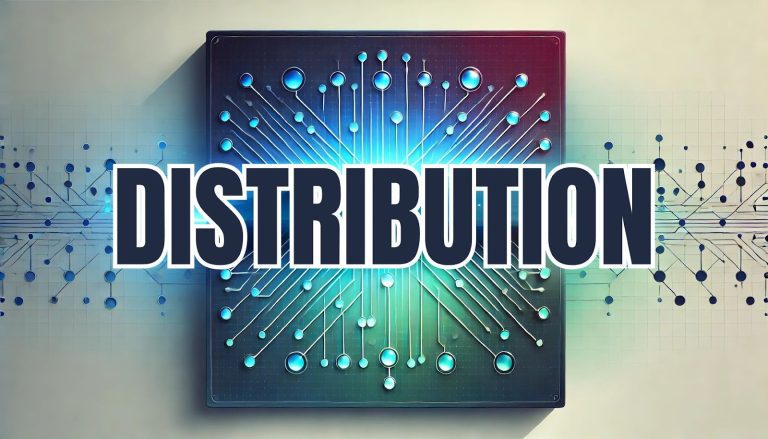Distribution is an easy process in the business world that ascertains the services and goods to get to their customers effectively. It refers to all systems, strategies, and logistics that have to be involved in moving products from manufacturers to end-users. Without effective distribution, businesses would find it quite challenging to meet customer demand, sound supply chain efficiency, and ultimately, profitability. It is the bridge between production and consumption. Channels, intermediaries, and management techniques are all a part of delivering the products at the right time and place.
In the paper, we discuss what distribution is, the role of the distributor, different types of distribution channels, distribution management, and the advantages and disadvantages of the direct and indirect methods of distribution systems. These are the most critical concepts that help businesses streamline operations toward satisfying their customers.
What is Distribution?
Distribution is the movement of products or services from producers to consumers. Among the key distribution activities, the most included are logistics, inventory management, order processing, and channel selection. Distribution ensures that the appropriate products reach the proper target market at the correct time and place. That is how effective distribution serves as the basis for extending market reach and supply chain optimization to enhance profitability.
It varies in different kinds of industries and markets. However, the primary objective is not distinct, which is to meet customer needs as effectively as possible regarding operational efficiency. It should also be noted that while undertaking the entire distribution activity, it also performs marketing functions to evoke demand creation and to promote the product.
Take a company that designs smartphones for the market. The company provides its smartphones through various channels that ensure a wide range of accessibility for the convenience of customers.
What is a Distributor?
The key intermediary in distribution is a distributor. They obtain products from manufacturing companies in mass quantities and retail those products to wholesalers, retailers, or customers. Value-adding is accomplished via inventory management and transport, market promotional activities, or distributor customer services. A distributor has been of primary importance because the production company cannot realize its entire geographical market and scale of sale.
Functions of Distributor
- Bulk Order: Distributors accept massive orders from manufacturers, which lessens the burden on producers
- Stock: They keep the products in warehouses and maintain sufficient stock to meet the demand in the market.
- Transportation and Deliveries: The distribution process will involve transporting goods by distributors to wholesalers, tailors, or customers.
- Market Exploration: They facilitate entry into new markets and penetration strength for the manufacturer using their network of associates.
- After-sales support: Typically, distributors are responsible for the technical support offered to customers, warranty, and customer service.
Examples
Electronics distributors purchase televisions from a manufacturer and sell them to regional retail stores. The distributor ensured timely delivery and managed stock levels and promotion campaigns to boost sales.
Distribution Management
Distribution management is a set of activities performed in the supply chain, including planning and distribution control. Its significance is ensuring products reach users without much hassle from manufacturers. This process involves coordinating logistics, distribution channels, and inventory to meet customers’ demands.
Components
- Logistics: Logistics is the central part of distribution management. Logistics is transportation, warehousing, and delivery activities. An efficient logistics system does not allow any delay and saves a lot of costs.
- Inventory Control: Distribution management ensures the correct stock availability to avoid stockouts or overstocking. This reduces the inefficiencies of operations and the cost of storage.
- Order Processing: Proper order processing means handling orders from customers within the expected time. Technology is what streamlines this process.
- Channel Selection: A firm decides whether it will use direct, indirect, or a hybrid form of distribution according to its marketing goals and the requirements of its customers.
- Technology Integration: It helps streamline with tools like ERP and WMS.
Benefits
- Improve a view of the supply chain
- Cost of operations goes low
- Helped customers achieve higher satisfaction in the form of speedy deliveries.
- It offers an opportunity in the context of increased competition in the market.
Distribution Channels
Distribution channels are the channels through which products are moved from manufacturers to consumers. It is one of the most critical activities that ensure the availability and accessibility of products. Therefore, companies should choose the proper distribution channels for their industry, target market, and product type.
Direct Distribution Channels
These channels take direct sales to customers without any intervention from intermediaries. These channels are usually undertaken by companies wanting elaborate control over the distribution chain.
- Examples: E-commerce, factory outlets, door-to-door sales.
- Industries: Technology, food delivery, luxury goods.
Indirect Distribution Channels
These indirect channels involve some intermediaries such as wholesalers, retailers, and distributors. Typically, they are used mainly by mass-market orientation organizations.
- Examples: FMCG products sold through supermarkets and retail shops.
- Industries: Consumer goods, pharmaceuticals, clothing.
Online Distribution Channels
E-commerce makes online channels the most prominent type of channel. They save costs for the business and are easy for the consumer.
- Examples: Amazon, Flipkart, Shopify.
- Industries: Electronics, fashion, books.
Hybrid Channels
Hybrid channels make use of a combination of both direct and indirect methods with the intent of acquiring maximum market coverage and efficiency. Businesses employ hybrid channels to fulfil various customer needs.
Role of Distribution Management in Supply Chain Management
It is referred to as the process that allows the goods to flow from manufacturers to customers at a very low cost and a satisfactory level of satisfaction—this coordination of production, logistics, and delivery results in a streamlined supply chain.
Key Activities for Distribution Management
- Chain of Supply – Smooth Product Flow: Distribution management ensures smooth product flow from the manufacturing stage to the end consumer stage by eliminating all delays or disturbances.
- Inventory Optimization: Proper stock management prevents overstocking, and stockouts are assured with distribution management. The costs of storage are minimized.
- Cost Control: Optimized distribution processes provide low transportation and operating costs and, therefore, an effective supply chain.
- Customer Satisfaction: It would ensure proper delivery on time and would bring forth better satisfaction levels of customers by ensuring that all distribution goes out right.
- Market Expansion: An effective distribution system ensures that a business expansion reaches to new markets and enjoys competitive advantages.
Advantages and Disadvantages of Direct Distribution Channels
With direct distribution, firms are in control of the total operations. Companies can decide on the price, branding, and customer relationship. The model also helps reduce the intermediate cost, hence increasing the profit margin. For example, Warby Parker’s use of the direct-to-consumer strategy makes glasses affordable while not suppressing quality and service.
Advantages
- Control: Manufacturers control the price, branding, and interactions with customers.
- Cost Saving: No intermediaries cut costs and, therefore, maximize profit margins.
- Customer feedback: The direct channels allow a business to capture valuable customer insight and make offerings better.
Disadvantages
- Limited Reach: Direct channels cannot cater to geographically dispersed markets.
- High Investment: It demands a lot of investment in infrastructure and logistics.
- Consuming Much Time: Too much time is spent building a direct relationship with customers and dealing with them.
Advantages and Disadvantages of Indirect Distribution Channels
Indirect distribution channels involve intermediaries like wholesalers or retailers, enabling businesses to reach a wider audience with less effort and infrastructure. However, it can reduce profit margins and limit control over the customer experience.
Advantages
- Able to Access Larger Markets and Diversified Customers: This channel is readily available for smaller markets and diversified customers due to intermediaries.
- Knowledge: Retailers and wholesalers know the local market and preferences.
- Lower Operating Burden: The firms can concentrate on manufacturing since the intermediaries are responsible for distributing and selling.
Disadvantages
- Lower Control: A firm will have lower control over the prices and customer contact.
- Higher Costs: Intermediaries add levels of costs to the distribution channel.
- Dependency: A firm will be dependent on the intermediaries and, hence, vulnerable to risks.
Distribution is the process by which the goods or services are passed on from the producers to the consumers through any channel, whether it be a retailer, distributor, or even an online portal.
Distribution FAQs
What is Distribution?
Distribution is the movement of products or services from producers to consumers.
What is a distributor?
A distributor is a middleman who buys the product in bulk from the manufacturers, sells it to the retailers or customers, and takes care of logistics and marketing.
What are distribution channels?
The route that the product follows from the manufacturers to the consumers is what refers to the distribution channels. This can either be a direct, online-based, wholesaler, or even retailer.
Why is distribution management critical?
Distribution management ensures the flow of products’ proper smoothness, saves costs, and gives satisfaction to customers by optimizing logistics and supply chain operations.
What is the difference between direct and indirect distribution?
Direct distribution deals with selling products directly to customers, while indirect distribution deals with selling through intermediaries, such as wholesalers and retailers, to the end consumer.


